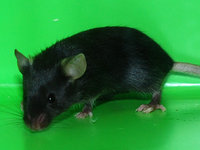Strain Data Sheet
RBRC01465
Strain Information | |
|---|---|
| Image |  |
| BRC No. | RBRC01465 |
| Type | Targeted Mutation |
| Species | Mus musculus |
| Strain name | B6(Cg)-Cacna1g<tm1.3Ksak>/KsakRbrc |
| Former Common name | Ca1G KO, C57BL/6-Cacna1g<-/+> |
| H-2 Haplotype | |
| ES Cell line | Bruce 4 [B6.Cg-Thy1<a>] |
| Background strain | |
| Appearance | |
| Strain development | |
| Strain description | Cacna1g gene is a member of the low-voltage-activated calcium channel that plays a critcal role in calcium ion transport in nerve, muscle and endocrine cells. This conditional Cacna1g deficient mice were generated by crossing with telencephalin specific Cre transgenic mice. |
| Colony maintenance | |
| References | Enhancement of hippocampal LTP, reference memory and sensorimotor gating in mutant mice lacking a telencephalon-specific cell adhesion molecule. Nakamura K, Manabe T, Watanabe M, Mamiya T, Ichikawa R, Kiyama Y, Sanbo M, Yagi T, Inoue Y, Nabeshima T, Mori H, Mishina M Eur. J. Neurosci., 13, 179-189 (2001). 11135016Conditional activation of RhoA suppresses the epithelial to mesenchymal transition at the primitive streak during mouse gastrulation. Fuse T, Kanai Y, Kanai-Azuma M, Suzuki M, Nakamura K, Mori H, Hayashi Y, Mishina M Biochem. Biophys. Res. Commun., 318, 665-672 (2004). 15144889 |
Health Report | |
|---|---|
| Examination Date / Room / Rack | |
Gene | |||||||
|---|---|---|---|---|---|---|---|
| Gene Symbol | Gene Name | Chr. | Allele Symbol | Allele Name | Common Names | Promoter | Diseases Related to This Gene |
| Cacna1g MGI:1201678 | calcium channel, voltage-dependent, T type, alpha 1G subunit | 11 | Cacna1g<tm1.3Ksak> | targeted mutation 1.3, Kenji Skimura | |||
| loxP | phage P1 loxP | 11 | loxP | ||||
Phenotype | |
|---|---|
| Phenotype annotation from literatures by Mammalian phenotype ontology | |
| Detailed phenotype data | |
Ordering Information | |
|---|---|
| Donor DNA | Phage P1 loxP site, mouse Cacna1g genomic DNA |
| Research application | Cre/loxP system |
| Specific Term and Conditions | ・The RECIPIENT of BIOLOGICAL RESOURCE shall obtain a prior written consent on use of it from the DEPOSITOR. ・The DEPOSITOR should be a co-author in articles when the users publish their data using these mice for 2 year after provided to the RIKEN BRC. ・Users should contact the DEPOSITOR in the case of application for any patents with the results from these mice. |
| Depositor | Kenji Sakimura (Niigata University) |
| Strain Status |  Frozen embryos Frozen embryos Frozen sperm Frozen sperm |
| Strain Availability | Recovered litters from cryopreserved embryos (2 to 4 months) Cryopreserved sperm (within 1 month) Cryopreserved embryos (within 1 month) |
| Additional Info. | Necessary documents for ordering:
Genotyping protocol -PCR- |
BRC mice in Publications |
|---|
Tracy ME, Tesic V, Stamenic TT, Joksimovic SM, Busquet N, Jevtovic-Todorovic V, Todorovic SM. CaV3.1 isoform of T-type calcium channels supports excitability of rat and mouse ventral tegmental area neurons. Neuropharmacology 135 343-354(2018) 29578032 |
Matsumoto-Makidono Y, Nakayama H, Yamasaki M, Miyazaki T, Kobayashi K, Watanabe M, Kano M, Sakimura K, Hashimoto K. Ionic Basis for Membrane Potential Resonance in Neurons of the Inferior Olive. Cell Rep 16(4) 994-1004(2016) 27425615 |
Choi S, Yu E, Hwang E, Llinás RR. Pathophysiological implication of CaV3.1 T-type Ca2+ channels in trigeminal neuropathic pain. Proc Natl Acad Sci U S A 113(8) 2270-5(2016) 26858455 |
Choi S, Yu E, Lee S, Llinás RR. Altered thalamocortical rhythmicity and connectivity in mice lacking CaV3.1 T-type Ca2+ channels in unconsciousness. Proc Natl Acad Sci U S A 112(25) 7839-44(2015) 26056284 |
Handforth A, Homanics GE, Covey DF, Krishnan K, Lee JY, Sakimura K, Martin FC, Quesada A. T-type calcium channel antagonists suppress tremor in two mouse models of essential tremor. Neuropharmacology 59(6) 380-7(2010) 20547167 |